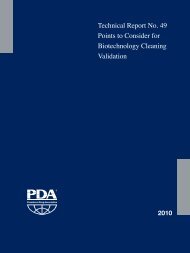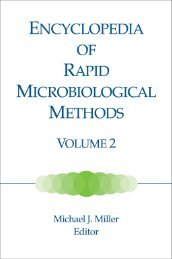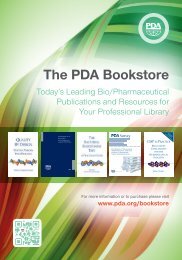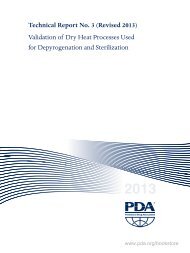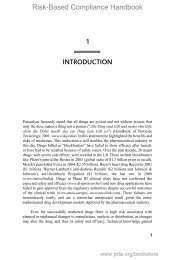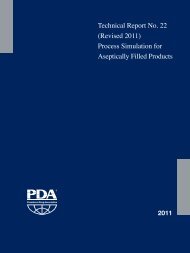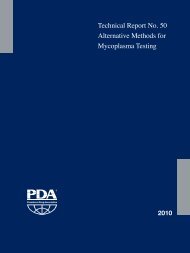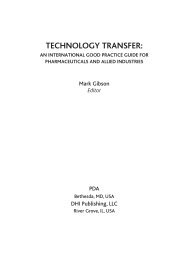Table of Contents - store.pda.org - Parenteral Drug Association
Table of Contents - store.pda.org - Parenteral Drug Association
Table of Contents - store.pda.org - Parenteral Drug Association
You also want an ePaper? Increase the reach of your titles
YUMPU automatically turns print PDFs into web optimized ePapers that Google loves.
5.9.4 Use <strong>of</strong> Different Safety Factors........... 38<br />
5.9.5 Different Routes <strong>of</strong> Administration..... 38<br />
5.9.6 Different Doses for<br />
Adults and Children............................ 38<br />
5.9.7 Human and Veterinary<br />
Products Manufactured on the<br />
Same Equipment................................ 38<br />
5.9.8 Residues <strong>of</strong> Genotoxic and Other Highly<br />
Hazardous Active Ingredients............. 38<br />
5.9.9 Limits Based on Analytical<br />
Detection Limits................................. 39<br />
5.9.10 Degradation <strong>of</strong> the Active Ingredient.. 39<br />
5.9.11 Limits Not Measureable..................... 39<br />
5.9.12 Limits for Organic Solvents................. 39<br />
5.9.13 Dedicated Equipment ........................ 40<br />
5.9.14 Dividing a Limit among Various<br />
Pieces <strong>of</strong> Equipment........................... 40<br />
5.9.15 .Limits for Preferential Transfer to a First<br />
Portion <strong>of</strong> the Next Product................ 40<br />
5.9.16 Limits for Biotechnology<br />
Manufacture....................................... 40<br />
5.9.17 Products with More Than One Active<br />
Ingredient........................................... 41<br />
5.10 Bioburden Limits...................................... 41<br />
5.11 Endotoxin Limits...................................... 42<br />
5.12 Visually Clean Criterion ........................... 42<br />
6.0 Sampling.............................................................43<br />
6.1 Sampling Method Selection........................... 43<br />
6.1.1 Direct Sampling Methods................... 43<br />
6.1.1.1 Visual Inspection........................... 43<br />
6.1.1.2 Instrumental Methods................... 44<br />
6.1.2 Rinse Sampling................................... 44<br />
6.1.2.1 Extraction Rinse Sampling for Small<br />
Parts.............................................. 46<br />
6.1.2.2 Solvent Reflux Sampling................ 46<br />
6.1.3 Swab and Wipe Sampling.................. 46<br />
6.2 Placebo Sampling........................................... 47<br />
6.3 Sampling for Microbial and<br />
Endotoxin Analysis......................................... 47<br />
6.4 Additional Considerations............................... 48<br />
6.5 Sampling Recovery Studies............................ 48<br />
6.5.1 General Considerations....................... 48<br />
6.5.2 Swab/Wipe Recovery......................... 49<br />
6.5.3 Rinse Recovery................................... 50<br />
6.5.4 “Recovery” in Visual Inspection......... 51<br />
6.5.5 Recovery for Bioburden and<br />
Endotoxin Sampling............................ 51<br />
6.6 Training and Qualification <strong>of</strong> Samplers............ 51<br />
6.6.1 Key Issues for Training<br />
for Swab Sampling............................. 52<br />
6.6.2 Key Issues for Training for Rinse<br />
Sampling............................................ 52<br />
6.6.3 Training for Visual Inspection.............. 52<br />
7.0 Analytical Methods............................................54<br />
7.1 Purposes <strong>of</strong> the Analytical Methods............... 54<br />
7.2 Practical Considerations in Selecting Analytical<br />
Methods......................................................... 54<br />
7.3 Specific vs. Nonspecific Analytical Methods for<br />
Validation Protocols........................................ 55<br />
7.3.1 Regulatory Status <strong>of</strong> Specific and<br />
Nonspecific Methods.................... 55<br />
7.4 Most Commonly Used Analytical Techniques.56<br />
7.4.1 Liquid Chromatography (LC)............... 56<br />
7.4.2 UltraViolet/Visible Spectrophotometry<br />
(UV/Vis).............................................. 57<br />
7.4.3 Total Organic Carbon (TOC)................ 57<br />
7.4.4 Conductivity....................................... 57<br />
7.4.5 Organoleptic Evaluation...................... 58<br />
7.5 Other Useful Analytical Techniques................ 59<br />
7.5.1 pH....................................................... 59<br />
7.5.2 InfraRed (IR)....................................... 59<br />
7.5.3 Light Microscopy................................ 59<br />
7.5.4 Titrations............................................ 59<br />
7.5.5 Gravimetric Analysis.......................... 59<br />
7.5.6 Enzyme Linked Immunosorbant<br />
Assay (ELISA).................................... 60<br />
7.5.7 Capillary Zone Electrophoresis (CZE)....60<br />
7.5.8 Atomic Absorption (AA) and<br />
Inductively Coupled Plasma (ICP)....... 60<br />
7.5.9 Ion Mobility Spectrometry (IMS)........ 60<br />
7.6 Microbial Test Methods.................................. 60<br />
7.6.1 Endotoxin........................................... 60<br />
7.6.2 Bioburden........................................... 60<br />
7.7 Analytical Method Validation.......................... 61<br />
7.7.1 General Principles............................... 61<br />
7.7.2 Compendial Methods......................... 62<br />
7.7.3 Visual Inspection................................ 63<br />
7.7.4 Bioburden Methods............................ 63<br />
7.7.5 Transfer to another Laboratory and<br />
Use <strong>of</strong> Contract Laboratories.............. 63<br />
8.0 Maintenance <strong>of</strong> Validated State.........................64<br />
8.1 Critical Parameter Measurement.................... 64<br />
8.2 Process Alarms.............................................. 64<br />
8.3 Change Control............................................... 65<br />
www.<strong>pda</strong>.<strong>org</strong>/book<strong>store</strong>



